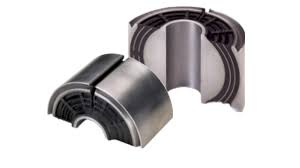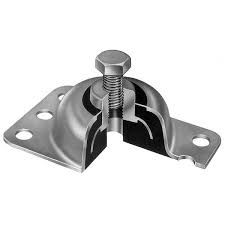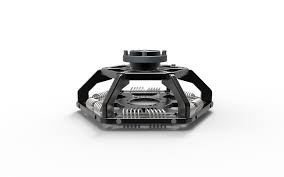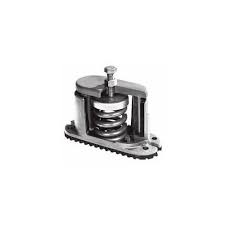Vibration isolator bushings are essential components for reducing the impact of vibrations in industrial machinery. Maximizing efficiency with vibration isolator bushings is crucial for ensuring optimal performance and longevity of machinery. By effectively reducing the transmission of vibrations, these bushings play a key role in minimizing wear and tear, improving overall equipment reliability, and reducing maintenance costs. In this article, we will explore the importance of vibration isolator bushings and how they can help maximize efficiency in machinery.
Vibration isolator bushings are designed to reduce the transmission of vibration and noise from machinery to its surroundings. By installing these bushings, machinery can operate more efficiently and with less impact on its surroundings. The bushings absorb and dissipate the energy generated by the machine, resulting in smoother operation and reduced wear and tear on the surrounding structures. This can lead to cost savings by minimizing damage to the machinery and its environment, as well as improving the overall performance and longevity of the equipment. Additionally, vibration isolator bushings can also improve workplace safety by reducing the exposure of workers to harmful levels of vibration and noise.
Vibration isolator bushings are used to reduce the transmission of vibration and noise from machinery to its surroundings. This can improve the efficiency of the machinery by minimizing the impact of vibration on its operation and surrounding environment. The bushings work by absorbing and dissipating the energy generated by the machine, resulting in smoother operation, reduced wear and tear on the surrounding structures, and potentially leading to cost savings. They can also contribute to improved workplace safety by reducing exposure to harmful levels of vibration and noise.
Understanding the Importance of Vibration Isolator Bushings

Vibration isolator bushings are essential for reducing the impact of vibrations on equipment and machinery.
Vibration isolator bushings are important because they help to reduce the transfer of vibrations from one component to another. This can help to protect sensitive equipment and machinery from damage caused by excessive vibration. Additionally, vibration isolator bushings can also help to improve the overall performance and lifespan of equipment by minimizing wear and tear. These bushings are commonly used in a wide range of applications, including automotive, aerospace, industrial machinery, and electronics. By effectively managing and reducing vibrations, vibration isolator bushings play a key role in ensuring the smooth and reliable operation of many different types of equipment and machinery.
The Advantages of Using Vibration Isolator Bushings
vibration isolation components

Incorporating vibration isolator bushings into industrial and mechanical applications can offer a wide range of benefits, including reducing noise levels and extending the lifespan of machinery.
Vibration isolator bushings offer several advantages for a wide range of applications. These include reducing noise and vibration levels, prolonging the lifespan of equipment, protecting sensitive components from damage, and improving overall performance. Additionally, they can help enhance the comfort and safety of operators and users by minimizing the effects of vibration and shock. Furthermore, vibration isolator bushings are cost-effective and easy to install, making them a practical solution for managing the negative impacts of vibration in various systems and machinery.
Selecting the Right Vibration Isolator Bushings for Your Equipment

Selecting the right vibration isolator bushings for equipment is crucial and requires consideration of factors such as load capacity, material composition, and environmental conditions.
Selecting the right vibration isolator bushings for your equipment is essential for maintaining the performance and longevity of your machinery. When choosing bushings, it's important to consider factors such as the weight and size of the equipment, the type and frequency of vibrations it will be subjected to, and the environmental conditions in which it will operate. To ensure the best fit, it's recommended to consult with a professional engineer or vibration specialist who can help determine the most suitable material and design for the specific needs of your equipment. Common options for vibration isolator bushings include rubber, neoprene, and silicone, each offering different levels of flexibility and resilience to dampen vibrations. It's also important to consider the installation and maintenance requirements of the chosen bushings, as well as their compatibility with the equipment's mounting points. Properly selected and installed vibration isolator bushings can help minimize wear and tear on your equipment, reduce noise levels, and improve overall performance.
Common Applications of Vibration Isolator Bushings

Vibration isolator bushings are commonly used in a variety of industries and machinery, including automotive, aerospace, construction, and manufacturing.
Vibration isolator bushings are commonly used in a variety of industrial and automotive applications to reduce the transmission of vibration and noise. They are often used in machinery, engines, suspension systems, and other equipment where minimizing the effects of vibration is crucial. Vibration isolator bushings are also commonly used in automotive suspension systems to improve ride comfort and reduce the transfer of road noise and vibration to the vehicle's occupants. Additionally, these bushings can be found in construction equipment, HVAC systems, and various types of machinery to help mitigate the effects of vibration on the equipment and surrounding environment. Overall, vibration isolator bushings are essential components in many applications where vibration and noise control are important factors.
Maintaining and Replacing Vibration Isolator Bushings
Proper maintenance and timely replacement of vibration isolator bushings are essential for ensuring optimal performance and safety.
Vibration isolator bushings should be regularly inspected for signs of wear, damage, or deterioration. It is important to maintain proper lubrication and ensure that the bushings are installed correctly to minimize vibration transmission. If the bushings show signs of wear or damage, they should be replaced promptly to prevent further issues. When replacing bushings, it is important to use compatible and properly sized components to maintain the effectiveness of the vibration isolation system. Regular maintenance and timely replacement of vibration isolator bushings can help to extend the lifespan of equipment and prevent costly repairs.
Design Innovation in Vibration Isolator Bushings
Advancements in materials and design techniques have led to improvements in vibration isolator bushings, resulting in components with superior vibration dampening and durability.
Design innovation in vibration isolator bushings involves the development of new materials, construction techniques, and designs that improve the performance and durability of the bushings. This may include the use of advanced polymers, composite materials, or specialized construction methods to better isolate and dampen vibrations in a variety of industrial and mechanical applications. Additionally, new designs may incorporate features such as variable stiffness or damping properties to tailor the performance of the bushings to specific operating conditions. Overall, design innovation in vibration isolator bushings aims to enhance the reliability and effectiveness of these critical components in minimizing vibration and extending the service life of machinery and equipment.
Understanding the Role of Vibration Isolator Bushings in Noise Control
Vibration isolator bushings also contribute to noise reduction in equipment and machinery, minimizing the generation of noise and creating a quieter and more comfortable working environment.
Vibration isolator bushings play a crucial role in noise control by reducing the transfer of vibrations from one component to another. They are commonly used in industrial machinery, automotive applications, and other equipment where vibration can lead to excessive noise. These bushings are designed to absorb and dissipate vibrations, thereby preventing them from being transmitted to surrounding structures or components. This helps to minimize noise levels and create a more comfortable and safer working environment. By understanding the principles and applications of vibration isolator bushings, engineers and designers can effectively mitigate noise and vibration issues in a wide range of settings.
The Future of Vibration Isolator Bushings in Industrial Applications
vibration dampening mounts
Vibration isolator bushings are expected to play an increasingly important role in meeting the evolving demands of industrial applications by providing effective vibration control and noise reduction.
Vibration isolator bushings are essential components in industrial applications, as they help to reduce the transmission of vibration and noise between different parts of machinery. The future of these bushings lies in their continued development to improve performance, durability, and efficiency. As technology advances, we can expect to see the use of more advanced materials and manufacturing processes to create vibration isolator bushings that can withstand harsh environments and extreme conditions. Additionally, the incorporation of smart technologies, such as sensors and predictive maintenance systems, can help to optimize the performance of these bushings and minimize the risk of unexpected failures. Furthermore, the integration of vibration isolator bushings in industrial automation and robotics will be crucial for ensuring smooth and precise operation of equipment, ultimately leading to increased productivity and cost savings. Overall, the future of vibration isolator bushings in industrial applications is promising, with ongoing research and innovation driving their evolution to meet the ever-changing demands of modern manufacturing processes.
In conclusion, incorporating vibration isolator bushings into machinery is a crucial step in maximizing efficiency and minimizing wear and tear on equipment. By reducing the vibrations and shocks experienced during operation, these bushings not only prolong the lifespan of the machinery but also improve overall performance. Investing in high-quality vibration isolator bushings can lead to significant cost savings and ensure a smoother and more reliable operation of industrial equipment. Therefore, it is important for businesses to consider the benefits of vibration isolator bushings in their maintenance and operational strategies.
See also
https://www.sunnexmounts.com/vibration-isolators/ https://www.hutchinsonai.com/vibration-isolation-products
0 comments:
Post a Comment